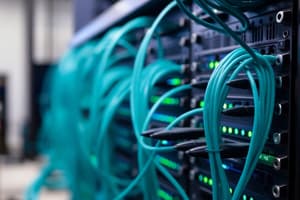Podcast
Questions and Answers
Which term best describes the connected PC and mobile devices that run network applications?
Which term best describes the connected PC and mobile devices that run network applications?
- Service providers
- End systems (correct)
- Switches
- Access networks
What is the primary function of routers and switches in a network?
What is the primary function of routers and switches in a network?
- Provide storage for network applications
- Encrypt data for secure transmission
- Connect different types of end systems
- Forward packets of data (correct)
Which of the following best describes the Internet's structure?
Which of the following best describes the Internet's structure?
- A single, centralized service
- A decentralized local network
- A network of networks (correct)
- An isolated group of servers
Which of the following is NOT considered a type of communication link?
Which of the following is NOT considered a type of communication link?
What do protocols in a network primarily control?
What do protocols in a network primarily control?
What is the primary function of protocols in network communication?
What is the primary function of protocols in network communication?
Which of the following best describes human protocols?
Which of the following best describes human protocols?
What role do hosts play at the network edge?
What role do hosts play at the network edge?
Which aspect of access networks is crucial for effective communication?
Which aspect of access networks is crucial for effective communication?
What is the significance of interconnected routers in a network?
What is the significance of interconnected routers in a network?
Flashcards
End Systems
End Systems
Computers or devices that connect to a network and run network applications.
Network Protocols
Network Protocols
Rules and standards for communication between devices on a network.
Packetswitching
Packetswitching
A method of data transmission where data is broken into small pieces (packets) and sent independently across a network.
Internet Service Providers (ISPs)
Internet Service Providers (ISPs)
Signup and view all the flashcards
Network Edge
Network Edge
Signup and view all the flashcards
Network protocols
Network protocols
Signup and view all the flashcards
Network Edge
Network Edge
Signup and view all the flashcards
End Systems
End Systems
Signup and view all the flashcards
Access Networks
Access Networks
Signup and view all the flashcards
Protocol Layers
Protocol Layers
Signup and view all the flashcards
Study Notes
Introduction to Computer Networking
- Note on PPT Slides: The slides are freely available for faculty, students, and readers. They are in PowerPoint format, allowing for animations, additions, modifications, and deletions. The authors request that if the slides are used in a class or on a website, the source is mentioned and copyright is acknowledged.
Chapter 1 Roadmap
- Section 1.1: What is the Internet?
- Section 1.2: Network Edge (end systems, access networks, links)
- Section 1.3: Network Core (packet switching, circuit switching, network structure)
- Section 1.4: Delay, Loss, Throughput in Networks
- Section 1.5: Protocol Layers, Service Models
- Section 1.6: Networks under Attack: Security
- Section 1.7: History
A Closer Look at Network Structure
- Network Edge: Hosts (clients and servers), servers often in data centers
- Access Networks: Physical media (wired, wireless communication links).
- Network Core: Interconnected routers, network of networks.
Access Networks and Physical Media
- Connection Methods: Residential access nets, institutional access networks (school, company), mobile access networks.
- Considerations: Bandwidth (bits per second) of access network, shared or dedicated.
Access Net: DSL
- DSL Technology: Data transmitted over existing telephone lines to central office DSLAM. Voice over DSL phone lines to telephone network.
- Transmission Rates: Typically 2.5 Mbps upstream, 24 Mbps downstream.
Access Net: Cable Network
- Cable Technology: Frequency division multiplexing transmits different channels in different frequency bands.
- HFC Technology: Hybrid fiber coax, asymmetric transmission rates (up to 30 Mbps downstream, 2 Mbps upstream).
Access Net: Home Network
- Home Network Structure: Wireless devices often combined in a single box, wireless access point (54 Mbps), wired Ethernet (100 Mbps), router, firewall, and NAT.
Enterprise Access Networks (Ethernet)
- Ethernet Usage: Typically used in companies, universities, etc.
- Transmission Rates: 10 Mbps, 100 Mbps, 1 Gbps, 10 Gbps.
- Connection Structure: End systems connect to Ethernet switch.
Wireless Access Networks
- Wireless Network Structure: Shared wireless access network connects to end system via base station ("access point").
- Wireless LANs: Within buildings (100 ft), 802.11b/g (WiFi): 11, 54 Mbps transmission rate.
- Wide-Area Wireless Access: Provided by telco (cellular) operators, 10s of km between I and 10 Mbps, 3G, 4G: LTE.
Host: Sends Packets of Data
- Host Sending Function: Takes application message, breaks into smaller chunks (packets) of length L bits. Transmits packet into access network at transmission rate R (link transmission rate, link capacity, or link bandwidth).
Physical Media
- Guided Media: Signals propagate in solid media (copper, fiber, coax).
- Unguided Media: Signals propagate freely (e.g., radio).
- Examples: Twisted pair (TP) (two insulated copper wires), Category 5 (100 Mbps), Category 6 (10Gbps), coaxial cable (two concentric copper conductors, bidirectional broadband, multiple channels). Fiber optic cable (glass fiber, high-speed operation, low error rate).
Physical Media: Radio
- Radio Link Types: Terrestrial microwave, e.g. up to 45 Mbps channels; LAN (e.g., WiFi), 11Mbps, 54 Mbps; wide-area (e.g., cellular), 3G cellular ~ few Mbps; satellite, Kbps to 45Mbps channel (or multiple smaller channels), 270 msec end-end delay, geosynchronous versus low altitude.
Packet Loss
- Queue/Buffer: Preceding link in the buffer has finite capacity.
- Packet Loss Condition: Packet arriving to a full queue is dropped.
Throughput
- Throughput Definition: Rate at which bits are transferred between sender and receiver.
- Instantaneous Throughput: Rate at a given point in time.
- Average Throughput: Rate over a longer period.
Throughput (More)
- Bottleneck Link: Link on end-end path that constrains end-end throughput.
Throughput: Internet Scenario
- Per-Connection End-End Throughput: Minimum of the connection transmission rate.
- Practice Bottleneck: In practice, one of the connection transmission rates or the backbone bottleneck transmission rate oftentimes is the bottleneck.
"Real" Internet Delays and Routes
- Traceroute Program: Measures delay across an end-end internet path towards a destination.
- Delay Measurement: Traceroute sends three packets, records the time interval between sending and replies; the router returns packets to the sender; and sender times the intervals.
"Real" Internet Delays, Routes
- Traceroute Example: Shows the delay measurements for a particular path using
traceroute. The example shows the path from a source (gaia.cs.umass.edu) to a destination (www.eurecom.fr) showing the delays between different routers, as well as whether a response was received.
Caravan Analogy
- Analogy: Compares data packet movement to a group of cars traveling on a highway.
- Concepts: Propagation time, transmission time, queuing delay.
- Comparison: Shows how propagation delay differs from transmission delay and demonstrates their interaction with queuing delay.
Queueing Delay (Revisited)
- Factors: Link bandwidth R, packet length L, average packet arrival rate a.
- Impact: La/R = 0, queueing delay small; La/R > 1, queueing delay large, average delay infinite.
Studying That Suits You
Use AI to generate personalized quizzes and flashcards to suit your learning preferences.
Related Documents
Description
Explore the fundamentals of computer networking in this quiz based on Chapter 1. Topics cover the Internet, network structure, communication links, and security protocols. Test your knowledge on critical concepts including delay, loss, and throughput in networks.




